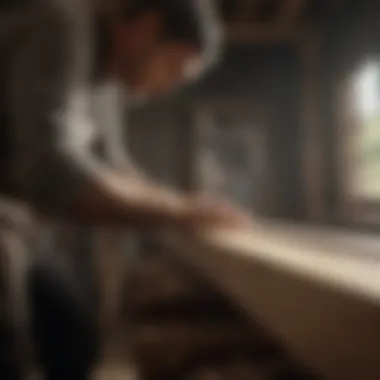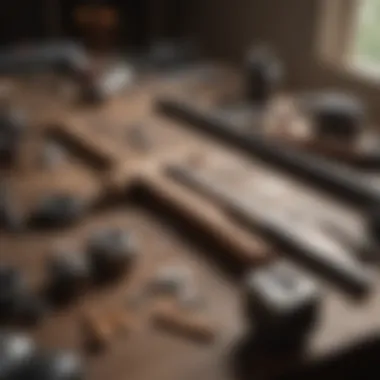Mastering the Art of Crafting a Cross: A Comprehensive Guide


Strategies for Success
To successfully build a cross, it's crucial to begin with clear goal setting techniques. Define the purpose of the cross, whether for personal use or as a religious symbol, to guide the entire construction process. Time management tips are invaluable at every stage, ensuring efficient progress and timely completion of the project. Additionally, incorporating productivity hacks can streamline the workflow, such as organizing materials beforehand and following a structured assembly plan.
Whether embarking on this endeavor alone or leading a team, understanding leadership psychology insights can greatly enhance the construction process. Developing emotional intelligence in leadership fosters a cohesive working environment and promotes effective communication skills. Implementing team building strategies is key to maintaining a harmonious collaboration throughout the cross-building journey.
Personal Growth and Development
Fuel personal growth and development by embracing mindset shifts for success. Cultivate a positive outlook towards challenges and view them as opportunities for learning and growth. Self-care practices play a vital role in sustaining motivation and focus during the cross-building process. Allocate time for rest and relaxation to prevent burnout and maintain peak performance. Overcoming challenges and adversities strengthens resilience and cultivates a growth mindset essential for mastering the art of constructing a cross.
Business Growth Strategies
Drawing parallels between cross-building and business growth, effective marketing and branding strategies are necessary to showcase the finished cross. Use innovative techniques to promote the cross's craftsmanship and significance, catering to a specific target audience. Financial management tips ensure that the resources allocated to the construction are optimized for cost-effectiveness and quality. Embracing innovation and entrepreneurship in the construction process infuses creativity and forward-thinking vision into the project, setting it apart as a testament to business acumen.
Case Studies and Real-Life Examples
Exploring success stories of entrepreneurs who have ventured into cross-building provides valuable insights into strategic planning and execution. Learn from leadership lessons shared by industry experts, implementing best practices and avoiding common pitfalls. Analyzing business turnaround case studies reveals the transformative power of resilience and adaptability in overcoming challenges. By studying real-life examples, one can glean inspiration and practical strategies to enhance their own cross-building journey.
Introduction
Building a cross is a meticulous process that involves attention to detail and precision to create a sturdy and visually appealing structure. Whether for personal or religious purposes, mastering the art of constructing a cross can be a rewarding endeavor. This article serves as a comprehensive guide, detailing each step from selecting the right materials to adding final decorative touches, providing readers with a holistic understanding of the construction process.


Understanding the Purpose of Building a Cross
When embarking on the journey of building a cross, it is essential to comprehend the significance behind this symbolic structure. For many, a cross represents faith, hope, and spiritual devotion. Understanding the purpose of a cross construction involves delving into its historical and cultural significance, as well as recognizing the emotional and symbolic value it holds for individuals and communities.
Materials Required for Building a Cross
To build a cross that is durable and visually striking, the selection of premium materials is crucial. Wood, commonly used for its natural beauty and strength, is a primary material for constructing crosses. Other materials like metal or composite materials may also be considered based on the desired aesthetics and durability. Each material choice comes with its unique characteristics, influencing the overall look and longevity of the cross.
Tools Needed for the Construction Process
A successful cross construction project requires the use of various tools to ensure accuracy and efficiency. Essential tools include measuring instruments for precise dimensions, cutting tools to shape the materials, and fastening tools to secure the components together. Additionally, finishing tools for detailing and protective coatings for preservation are vital to achieve a professional and long-lasting result.
Safety Precautions to Keep in Mind
Prioritizing safety during the cross construction process is paramount to prevent accidents and ensure a smooth workflow. Safety precautions include wearing appropriate protective gear such as gloves, goggles, and masks to safeguard against injuries. Adhering to proper tool handling techniques and maintaining a clutter-free workspace further minimizes risks. Regularly inspecting tools and ensuring a well-ventilated environment also contribute to a safe and controlled construction process.
Preparing the Workspace
When embarking on the journey of building a cross, one of the pivotal phases is preparing the workspace. This stage lays the foundation for a seamless construction process, ensuring efficiency and safety throughout. The significance of preparing the workspace cannot be overstated, as it paves the way for organized and structured work.
Clearing the Area for Construction
Before diving into the construction of the cross, it is imperative to clear the area designated for the project. This step involves removing any debris, obstacles, or clutter that might hinder the construction process. A clean and unobstructed workspace not only promotes a sense of clarity but also minimizes the risk of accidents or damage to materials. By meticulously clearing the area, you set the stage for a focused and productive construction environment.


Organizing Materials and Tools
Organizing materials and tools is a critical aspect of preparing the workspace for building a cross. Efficient organization not only streamlines the construction process but also eliminates unnecessary delays caused by misplaced items. Prior to commencing the construction, ensure all required materials and tools are readily accessible and neatly arranged. By maintaining a well-organized workspace, you enhance productivity and prevent interruptions that may impede progress.
Setting Up a Safe Working Environment
Safety should always be a top priority when preparing the workspace for constructing a cross. Setting up a safe working environment involves implementing precautions to mitigate potential hazards and promote a secure construction environment. This includes wearing appropriate safety gear, such as gloves and goggles, as well as clearing away any sharp objects or hazardous materials. Additionally, establishing clear pathways and work areas further enhances safety measures, reducing the likelihood of accidents or injuries. By prioritizing a safe working environment, you safeguard both yourself and the quality of the construction process.
Constructing the Cross
Constructing the cross is the pivotal stage in this article, where precision and attention to detail come into play. This section delves deep into the process of turning raw materials into a visually striking and stable cross. Understanding the measurements, assembly techniques, and decorative elements are crucial aspects covered in constructing the cross. Readers will gain insights into the meticulous craftsmanship required to create a durable and aesthetically pleasing crucifix.
Measuring and Cutting the Base Material
When it comes to Determining the Desired Height and Width, the accuracy of measurements sets the foundation for a sturdy cross. This step determines the final dimensions of the cross, impacting its overall appearance and stability. The guide emphasizes the significance of precise measurements, ensuring the cross achieves the intended proportions and aesthetic appeal for its purpose. Using Precision Tools for Accurate Cuts plays a vital role in achieving clean and seamless cuts for assembling the cross. Employing high-quality tools like saws and measuring instruments is imperative for precise outcomes, minimizing errors during the construction process. Readers are enlightened on the effectiveness of using advanced tools for enhanced accuracy and professionalism throughout the project.
Assembling the Cross
The section on Securing Pieces Together focuses on the structural integrity of the cross. Exploring the methods to securely join the components ensures the longevity and strength of the final structure. Emphasizing proper fastening techniques and materials underscores the importance of robust connections for a stable cross. Ensuring Stability and Symmetry contributes to the overall balance and visual harmony of the cross. Techniques to maintain symmetry and stability throughout the assembly process are detailed, guaranteeing a well-built and visually appealing cross that withstands the test of time.
Adding Decorative Elements
Incorporating Painting or Staining the Cross adds a personalized touch and protection to the wooden surface of the cross. Choosing suitable colors or stains enhances the aesthetic appeal and longevity of the cross, catering to individual preferences and intended settings. Incorporating Embellishments introduces creative elements to elevate the cross's visual impact. From intricate carvings to symbolic additions, embellishments allow for personalization and artistic expression, creating a unique and meaningful crucifix. Readers are guided on the selection and application of embellishments to enhance the beauty and significance of the finished cross.


Finishing Touches
Once the construction process of the cross is near completion, the focus shifts towards adding the final touches that bring the project together seamlessly. In this crucial phase, meticulous attention to detail is paramount to ensure the finished cross meets the desired standards of quality and appearance. Finishing touches serve not only as the concluding step in the construction process but also as a significant factor in enhancing the overall aesthetic appeal and durability of the final product.
Inspecting the Cross for Quality
Before finalizing the construction of the cross, a thorough inspection must be conducted to guarantee its quality and structural integrity. This step involves closely examining every aspect of the assembled cross, from the precision of cuts to the stability of joints. By inspecting the cross for quality, any potential flaws or irregularities can be identified and rectified, ensuring that the finished piece meets the desired standards of craftsmanship and durability.
Finalizing the Construction
Smoothing Edges and Surfaces
Smoothing edges and surfaces of the cross is a critical aspect of the finishing process that contributes significantly to the aesthetics and safety of the final product. By meticulously smoothing out rough edges and surfaces, the overall look of the cross is refined, creating a professional and polished appearance. This step not only enhances the visual appeal of the cross but also serves to prevent any accidental injuries or damage that may occur due to sharp or uneven surfaces. The careful smoothing of edges and surfaces adds a sophisticated touch to the cross, elevating its overall quality and desirability.
Applying Protective Coating
Applying a protective coating to the completed cross is essential for ensuring its longevity and resistance to external elements. This process involves covering the surface of the cross with a specialized coating that shields it from moisture, UV rays, and other environmental factors that could potentially compromise its structural integrity. The protective coating not only enhances the durability of the cross but also helps preserve its aesthetic appeal by preventing fading or weathering over time. By applying a protective coating, the cross is not only safeguarded against normal wear and tear but also maintains its pristine appearance for an extended period, reinforcing its value and longevity.
Conclusion
Building a cross is more than just a construction project; it embodies artistry, dedication, and precision. In this article, we have meticulously outlined the steps required to craft a visually appealing and robust cross. Paying attention to detail from materials selection to final touches ensures a seamless construction process. By following this comprehensive guide, individuals can create crosses that not only stand the test of time but also hold deeper significance, whether for personal contemplation or religious reverence. The importance of the conclusion lies in encapsulating the essence of the entire building process, emphasizing the craft's intricacies and the fulfillment derived from mastering this ancient art.
Admiring Your Handiwork
After completing the construction of a cross, it is essential to take a moment to admire the handiwork. Viewing the finished piece from different angles allows one to appreciate the symmetry, stability, and attention to detail put into its creation. Observing the crafted cross not only instills a sense of accomplishment but also provides an opportunity to reflect on the effort invested and the skills honed during the building process. Admiring your handiwork is a moment of pride, showcasing your craftsmanship and dedication to creating a visually striking and meaningful symbol.
Reflecting on the Building Experience
Reflecting on the journey of building a cross delves beyond the tangible outcome, offering insight into personal growth and achievement. The building experience is a testament to patience, perseverance, and precision, highlighting the importance of commitment and craftsmanship. Each step in the process serves as a learning opportunity, refining skills and nurturing a sense of creativity. Reflecting on the building experience cultivates a deeper appreciation for the art of construction and the significance of creating something by hand. It allows individuals to acknowledge their progress, challenges overcome, and the satisfaction that comes from transforming raw materials into a piece of art.



